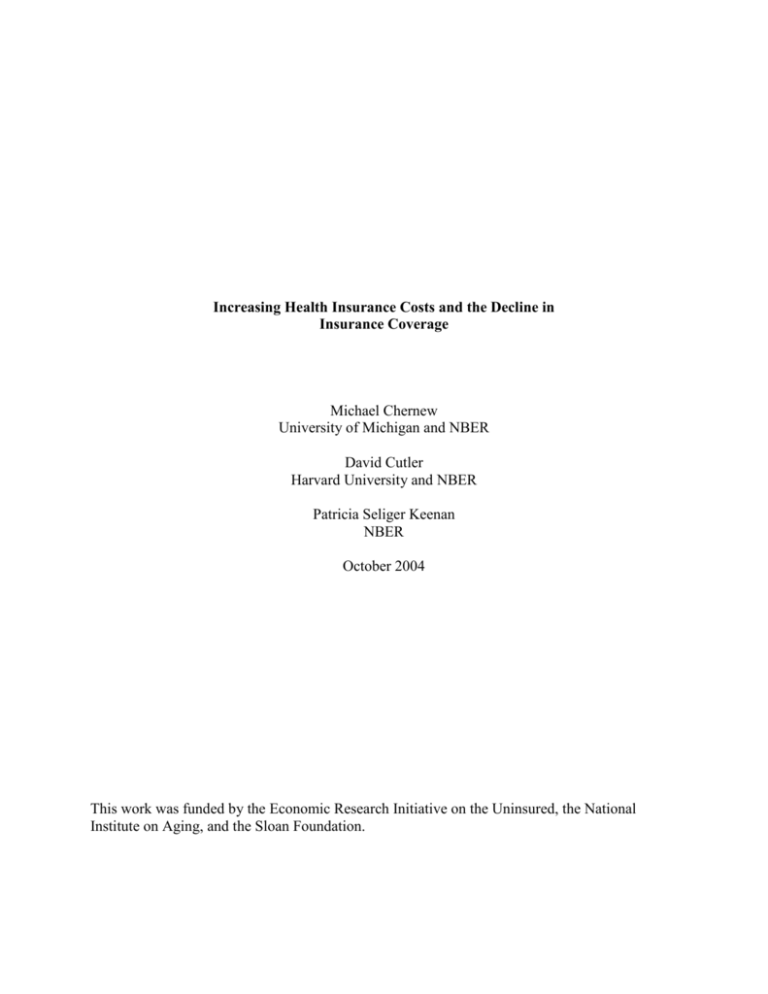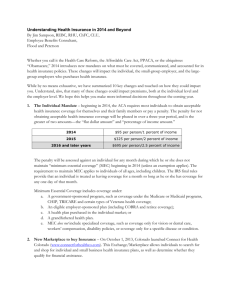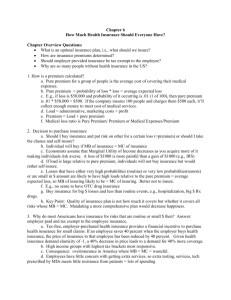Increasing Health Insurance Costs and the Decline in Insurance
advertisement

Increasing Health Insurance Costs and the Decline in Insurance Coverage Michael Chernew University of Michigan and NBER David Cutler Harvard University and NBER Patricia Seliger Keenan NBER October 2004 This work was funded by the Economic Research Initiative on the Uninsured, the National Institute on Aging, and the Sloan Foundation. Abstract Objective: To determine the impact of rising health insurance premiums on coverage rates. Data Sources & Study Setting: Our analysis is based on two cohorts of non-elderly Americans residing in 64 large MSAs surveyed in the Current Population Survey in 1989-1991 and 19982000. Measures of premiums are based on data from the Health Insurance Association of America and the Kaiser Family Foundation/Health Research and Educational Trust Survey of Employer-Sponsored Health Benefits. Study Design: Probit regression and instrumental variable techniques are used to estimate the association between rising local health insurance costs and the falling propensity for individuals to have any health insurance coverage, controlling for a rich array of economic, demographic, and policy covariates. Principal Findings: Over half of the decline in coverage rates experienced over the 1990s is attributable to the increase in health insurance premiums (2.0 percentage points of the 3.1 percentage point decline). Medicaid expansions led to a 1 percentage point increase in coverage. Changes in economic and demographic factors had little net effect. The number of people uninsured could increase by 1.9 to 6.3 million in the next decade if real, per capita medical costs increase at a rate 1 to 3 percentage points above the GDP growth rate. Conclusions: Initiatives aimed at reducing the number of uninsured must confront the growing pressure on coverage rates generated by rising costs. 2 INTRODUCTION The 1990s were a decade of relative prosperity, yet the percentage of Americans without health insurance coverage rose over 17% between 1990 and 1998. This decline generally reflects a drop in the rates of employer-sponsored coverage, a trend that began in the late 1970s (Farber and Levy, 2000). The drop in coverage has raised concern among policy makers in light of a variety of studies that highlight the difficulty that the uninsured have in accessing care, and their resulting poorer outcomes (Institute of Medicine, 2002; Serafini and Stone, 2002). Designing policies that will effectively address this problem requires understanding why coverage rates have fallen and anticipating how coverage will change in the future. Despite a relatively large literature investigating the determinants of insurance coverage, relatively few studies use multivariate techniques to examine factors contributing to the decline in coverage over time. These studies show that increased reliance on part-time workers (Fronstin and Snider, 1996), industry shifts (Long and Rogers, 1995), a combination of labor market factors (Kronick and Gilmer, 1999; Glied and Stabile, 2000), or crowdout (Blumberg et al., 2000; Currie and Yelowitz, 1999; Cutler and Gruber, 1996a,b) only partially explain the decline in employer provided insurance. An alternative explanation is that coverage has dropped because the cost of insurance has risen. In contrast to substantial media coverage linking rising premiums to declining coverage rates, empirical evidence quantifying the relationship between premiums and coverage is limited. The studies that use multivariate techniques to examine the relationship between health care costs and coverage rates find support for the view that increasing costs decrease coverage (Kronick and Gilmer, 1999; Fronstin and Snider, 1996; Cutler, 2002). Kronick and Gilmer (1999) rely on national measures of health care costs, relative to income, and generate most of 3 the variance in the cost to income ratio from variation in income, not health care costs. Fronstin and Snider (1996) analyze state level data from 1988 to 1992 and include only one cost proxy, the price of a hospital day. Cutler (2002) uses national level data on employee contributions. Thus these studies do not directly measure the effects of rising premiums on coverage, nor do they attempt to adjust for potential reverse causality that arises because declining coverage may lead to higher premiums. Further, existing studies typically focus on employer-sponsored coverage, which, though important, does not give a full picture of the effects of rising premiums on coverage because some individuals may substitute public for private coverage. Finally, these studies typically do not devote substantial attention to controlling for potential confounding explanations for the decline in coverage such as the expansion in Medicaid or changing tax policy. This paper explores the relationship between health care premiums and coverage rates. It takes advantage of wide geographic variation in changes in premiums and coverage rates. Thus the variation in premiums that we use is broader than that used in existing literature and less likely to be confounded with other secular trends. In contrast to existing work, we also use instrumental variable techniques to address the potential for reverse causality between rising costs and coverage rates. The instrumental variable techniques also adjust for potential measurement error in our premium data. We focus on coverage from any source, which gives a more complete picture of coverage because some individuals may switch from private to public coverage. Finally, we control for a wide range of factors associated with alternative explanations of coverage declines. We thus quantify the link between rising health insurance premiums and rates of insurance coverage, addressing limitations of the existing literature. 4 CONCEPTUAL FRAMEWORK The price of insurance can be measured in several ways. Economics textbooks define the price of health insurance as the loading fee, or the difference between the premium and expected payout (Feldstein, 1999; Phelps, 1997). 1 An alternate approach uses premiums or costs to measure price. In contrast to a price measure based on the load, the use of premiums as a measure of price captures the effects of rising medical expenditures on coverage rates.2 Standard economic theories of insurance coverage predict that as the magnitude of the potential loss rises, demand for coverage would increase. Interpreting rising premiums as an increase in the potential loss is reasonable because most research examining the causes for rising expenditures attributes expenditure increases to advances in medical technology, rising premiums may reflect services individuals value (Chernew et al., 1998; Cutler, 1995; Newhouse, 1992). This analysis would lead one to expect coverage rates would increase as medical expenditures rise. For certain medical services this has certainly been true. For example, coverage rates for pharmaceuticals have risen as pharmaceutical expenditures have risen. Why might rising premiums be associated with falling coverage? One possibility is that premiums reflect not only desired medical expenditures, but also moral hazard (Pauly, 1968). Although on average individuals may desire new medical technology, at the margin the premiums may reflect growing moral hazard. The magnitude of moral hazard is somewhat controversial (Nyman, 1999), and very little work examines changes in moral hazard over time. 1 Some medical expenditures may be purchased with pre-tax dollars so variation in tax rates may also affect the cost of care in one in uninsured, but the medical expenditures are only deductible after a threshold is reached, and we believe that tax rates are largely correlated with the load. Glied (2002) provides some evidence that loading costs have not increased substantially over time. 5 Note that changing moral hazard does not require changing insurance contracts but may instead arise simply because of new technology even if insurance contracts stay constant. On one hand, a growing body of work reports the value of many of the new medical advances but notes that value is not uniform across all clinical areas (Cutler and McClellan, 2001). On the other hand, the 1990s have been characterized by growing attempts to constrain health care costs, suggesting that moral hazard may be a growing (or just a more recognized) concern. Another possibility is that the relative value of health insurance compared to the medical care one would receive if uninsured is changing over time. Technological progress is widely considered to be responsible for driving up premiums (Chernew et al., 1998; Cutler, 1995; Newhouse, 1992). The new technologies may also be incorporated to an extent into care provided to the uninsured, particularly for acute services. For some individuals, the value of additional services provided by health insurance coverage above the amount of care available if uninsured may not be worth the cost of the insurance package. In fact, work by Fisher and colleagues suggests that satisfaction is not greater in areas that use medical resources more intensively (Fisher et al., 2003). If technological progress brings with it more moral hazard, one would expect more individuals to decline options for coverage.3 A third possibility is that rising premiums increase the incentives for low risk individuals to separate from high risk individuals in the risk pool. If this is the case adverse selection in the insurance market may increase over time and the market may have a tendency to unravel as costs rise. Thus rising premiums would lead to declining coverage rates. 2 Marquis and Long, 1995, and Swartz, 1988, provide examples of cross sectional work that estimates the elasticity of demand for individual health insurance coverage using premium data. 6 METHODS Study population We examine changes in insurance coverage from 1988-90 to 1997-99. Because essentially all of the elderly have coverage through Medicare, we consider only the non-elderly population. We divide people into health insurance units (HIUs) reflecting coverage under typical health insurance policies (Cutler and Gruber, 1996a). The initial sample size is 858,894 people. From these data, we keep people in the 64 large Metropolitan Statistical Areas for which we have matching data on health insurance premiums. The resulting sample size is 333,431. Data Our primary data source for insurance coverage and individual level demographic variables is the Current Population Survey (CPS). The CPS asks about insurance coverage in the previous year. To increase sample size, we pool data from the 1989-91 surveys for the early time period and from the 1998-2000 samples for the later time period. Our primary measure of the change in health insurance premiums is based on data from the Health Insurance Association of America and the Kaiser Family Foundation/Health Research and Educational Trust Survey of Employer-Sponsored Health Benefits (KPMG Survey, 1988, 1989, 1998) and (Kaiser Family Foundation, 1999). These surveys obtain information about the type of policies offered and their premiums. We pool surveys from 1988 and 1989 for the early years and 1998 and 1999 for the later years. 3 See Cutler (2002) for a more detailed discussion. The effect of technological progress of the utility of being uninsured vs. insured depends on the availability of charity care, norms of practice, and the marginal utility of the incremental cost of insurance to cover new services. 7 We include Metropolitan Statistical Areas in our sample if there are at least 10 premiums observations in both the early and late time periods, to minimize sampling error. This yields a total of 64 Metropolitan Statistical Areas. There are 2,111 premium observations in the early years and 4,006 observations in the later years. The MSAs in our sample account for about half of the total United States non-elderly population. Premiums are for an individual policy offered in a group setting. To account for the differing nature of health insurance coverage, we adjust premiums using a regression model relating plan premium to type of plan (HMO, PPO, POS plan, indemnity plan) and several plan benefit characteristics. Specifically, we regressed the premiums on: plan type, whether an employer offers multiple plans, interactions of plan type and employer offering multiple plans, and interactions of plan type and time period; plan deductible, coinsurance, and copay amounts; whether plans offer prescription drugs, outpatient mental health benefits, inpatient mental health benefits, and maternity benefits; firm size, industry, and a set of MSA dummies and MSA dummies interacted with time period to measure the plan type and benefit adjusted premiums in an MSA. The coefficients from this regression were generally reasonable, indicating that more generous benefits implied greater premiums, and the r-squared from this regression was 0.26. To check the reasonableness of this premium measure, we correlated it with Medicare Part B spending at the MSA level (=0.47) and per capita personal health care spending in the state for the non-elderly population (=0.62). Medicare spending data are from CMS, Office of the Actuary. State spending is calculated from CMS state health accounts data and excludes Medicare spending. Our premium measure may be a more accurate reflection of costs for the non-elderly than Medicare spending because it is less affected by changing costs for services such as home care. It is likely a better measure than state health care spending because insurance 8 markets are likely smaller than the state. State spending blends cost trends across multiple urban and rural areas. Undoubtedly, measurement error in the premium measure remains. If the associated bias is large, our instrumental variable models, discussed below, will provide a better measure of the relationship between rising premiums and coverage. In our models we include two sets of controls (taken from the CPS). Demographic controls are intended to absorb some of the unobserved factors that could confound the analysis. The second set of explanatory variables is designed to control for competing explanations for declining coverage that have been proposed in the literature. We have tried to adopt the measurement approaches used in all the other work to better control for competing explanations. We include the following demographic variables for each individual and the head of their HIU: age, gender, race/ethnicity, education, marital status, industry, occupation, full-time/parttime work status, government versus private employer, and firm size. We also include indicators of whether there are no workers or more than one worker in the HIU; interactions of being a spouse or a child in a family with multiple workers; binary variables for the income decile the HIU falls into, calculated separately for singles and married people, and interactions of income decile and marital status of the HIU head. We include interaction terms between these variables and a binary variable capturing observations in the later period to allow for the possibility that their effect changes over time. Several metropolitan area-level demographic factors are included based on CPS data. These capture market level effects and competing explanations for the decline in coverage. The MSA level covariates include the share of the population that is foreign born, the share of the population in the metropolitan area that is non-white, the share that is elderly, average HIU income, and the share of women that are working. We also include the local unemployment rate, 9 which is from BLS data available on the Area Resource File. Unless otherwise indicated, we do not interact the MSA-level or policy covariates with a time period dummy. Two of the important potential explanations for declining coverage that have been explored in the literature are rising Medicaid eligibility and falling tax subsidies. We control for these explanations using the approaches followed by studies focusing on these explanations. Specifically, we generate measures of the generosity of Medicaid coverage of children following the approach of (Cutler and Gruber, 1996a), using information from IHPP, 1988, 1989, 1990 (Intergovernmental Health Policy Project, 1988), (Intergovernmental Health Policy Project, 1990) and (Intergovernmental Health Policy Project, 1991) and NGA, 1990, 1999, (National Governors’ Association, 1990) and (National Governors’ Association, 1999). They measure Medicaid eligibility by the fraction of HIU health spending eligible for Medicaid, based on family composition, which captures the role of Medicaid eligibility in the context of family health insurance decisions. This is calculated by applying state regulations to CPS data to assess generosity at the state level and adding controls for the fraction of family health spending attributable to each child age.4 Data on Federal, State and Local income tax rates are obtained for 1990 and 1999 from the TAXSIM program of the National Bureau of Economic Research (Feenberg and Coutts, 1993). To control for changing taxes, we follow the methods of Gruber (2001). Specifically, we match average tax rates to individuals based on their state of residence, income decile, marital status, and year (Gruber, 2001). Gruber (2001) argued that this instrumental variables measure of taxes is preferable to calculating tax rates at the individual level to avoid endogeneity associated with the relationship between coverage, income, and taxes. 4 A list of assumptions used to estimate whether individuals meet state Medicaid eligibility rules is available from the authors. 10 We measure the availability of charity care in each metropolitan area as the number of public and teaching hospital beds per thousand residents, obtained from the AHA and ARF (American Hospital Association 1991, Area Resource File, 2001). We measure these variables only in 1990 to minimize reverse causality issues that may arise because these measures could be affected by insurance, rather than the reverse. We include this variable as an interaction with time period, to examine whether the effect of charity care availability changes over time. State regulations in the 1990s established many restrictions on insurance pricing that could affect coverage (Simon, Working Paper Series #2001). We indicate with a dummy variable whether the state has passed rating reforms, which limits the variability in prices across groups, or enacted guaranteed issue, which requires insurers to sell at least some policies to all groups, for the small-group insurance market. Specification In our base specification we estimate probit regression models for the probability that an individual has health insurance coverage from any source. The regressions are weighted using the Current Population Survey sampling weights to reflect the national sample. Our standard errors are clustered by MSA-time period, which accounts for unobserved factors that are correlated within MSA/time period cells. Our predictions about the impact of insurance premiums and other factors on coverage are obtained from these probit regression estimates. We control for general time trends and time invariant areas traits using a dummy variable equal to 1 for the late sample, and dummy variables for each metropolitan area. To project forward, we approximate the effect of rising premiums over GDP growth by inflating premiums by 1, 2, and 3 percent average annual growth for 10 years, holding income and all other variables constant. 11 The nature of the insurance questions in the Current Population Survey changed somewhat over time (Fronstin, 2001; Mills, 2002; Swartz, 1997). Time trends in insurance coverage are thus subject to some uncertainty. These changes in question wording should not affect our analysis, however, because we control for national trends and rely on differential changes across areas to identify the effects of rising premiums and other covariates. We were concerned about two potential sources of bias in our probit estimates. First, our premium data is measured with noise, both because of the small sample in the survey of employers and because of imprecision in our ability to adjust for all benefit traits. This measurement error will lead to an underestimate of the effects of premiums on coverage. Second, there is the potential for reverse causality due to selection, if providers in markets with more uninsured individuals raise prices or shift costs to private insurers. This bias would overstate the effects of premiums on coverage. To address these dual concerns we estimated linear probability models analogous to the probit model using instrumental variable (IV) techniques (McClellan et al., 1994). As an instrument for private premiums we used Medicare Part B and state level per capita spending. The joint significance test on the two spending variables from the first stage regression gives an F statistic of 52.66, indicating that the two spending measures are highly correlated with premiums, which is a condition for instrumental variables analysis (Staiger and Stock, 1997). In addition, the partial R-squared is 0.77, suggesting that the instruments have sufficient explanatory power to identify the system.5 5 The partial R-squared is obtained from a regression of premiums adjusted for all other covariates on Medicare Part B spending and state spending similarly adjusted. 12 RESULTS Descriptive findings In the MSAs in our sample, health insurance coverage fell 3.1 percentage points. This compares to 2.6 percentage points nationally. There was substantial variation across MSAs. The 25% of MSAs with the most favorable coverage change experienced losses of less than -.007 percentage points (or coverage gains), whereas the 25% of MSAs with the worst coverage change experienced coverage losses in excess of -4.2 percentage points. The annual cost of the average health insurance policy increased by $818 in inflationadjusted dollars over the decade, or 53 percent. Again there was substantial geographic variation, with the upper quartile of cost growth being $1,056 and the lower quartile being $641. Figure 1 shows the correlation of MSA level coverage changes and MSA premium changes. In general, areas with larger premium increases experience greater declines in insurance coverage. Multivariate results Table 1 reports descriptive statistics for our sample for the main covariates. The probit models confirm the impact of premiums on coverage (Table 2, column 1). Each $1,000/year of increased premiums leads to declines in coverage of 2.6 percentage points (+/- 1.5 percentage points; p=.001), holding constant individual and HIU characteristics, the economic environment, and other policy variables. Among the other policy variables, Medicaid eligibility increases are associated with increases in insurance coverage. Every 10 percentage point increase in Medicaid eligibility for children leads to a 2.2 percentage point increase in insurance coverage (+/- 0.3 percentage points; p<.001). State insurance reforms were not statistically significantly 13 associated with insurance coverage. Similarly, uncompensated care availability is not statistically significantly associated with declines in insurance coverage. Contrary to expectations, increases in the tax subsidy to health insurance are significantly associated with reductions in insurance coverage rates. We do not attach much importance to this result since there is little variation in changes in tax rates across metropolitan areas in our sample and the result it is not very robust to changes in specification Individual-level economic and demographic changes (not reported) are associated with changes in coverage. Higher income, dual-headed families are more likely to have insurance coverage. Area-level economic and demographic changes, as expressed in the percentage of women that are working, average HIU income, unemployment rates, and the percentage of the population that is elderly, non-white, or foreign born, are not related to changes in coverage. Columns 2 and 3 of Table 2 show the results for regressions with private and public coverage as the outcomes. The results generally are consistent with theory, indicating variables that one would expect to operate primarily through their effects on private coverage do have their effect in that population, without affecting public coverage. For example, premiums and percent working spouses operate almost exclusively though private coverage. Specifically, a $1,000 increase in private premiums is associated with a 3.9 percentage point decline in private coverage (+/- 2.1 percentage points, p<0.001. The coefficients on the percent eligible for Medicaid indicate a negative effect of Medicaid eligibility on private coverage, and a positive effect on public coverage. This is consistent with existing literature that suggests Medicaid expansions result in some substitution of private coverage with public coverage, commonly referred to as ‘crowd out.’6 6 Our estimates suggest that the drop in private coverage associated with the Medicaid expansions is about 20% of the net increase in Medicaid coverage associated with the expansions. Because some individuals who lose private 14 Table 3 reports the results using IV techniques to address the potential endogeneity of premiums and measurement error. Column 1 simply replicates the base probit results for comparison. Column 2 reports the analogous results for a linear probability model, without using IV techniques, to illustrate the effects of the change in functional form. The estimates are very consistent, with the one notable exception of the tax rate result, which becomes statistically insignificant. It is the only coefficient sensitive to such a specification change. Column 3 replicates the linear probability model, but uses IV techniques to adjust both for measurement error in the premium data and potential endogeneity of premium changes. Our identifying instruments are Medicare Part B and state level per capita spending levels. The IV models revealed results that were about 22 percent larger. This suggests measurement error is a more significant bias than reverse causality, though on balance the premium results were similar to those from the probit model.7 The conclusions from the IV analysis regarding other variables were also similar to those from the linear probability model that did not use IV techniques. Implications for Insurance Coverage Figure 2 shows the implications of premium increases and other factors for changes in insurance coverage using the more conservative probit results. The increase in health insurance coverage may become uninsured rather than gain Medicaid coverage, this does not necessarily mean that 20% of individuals who gained Medicaid coverage formerly held private coverage. While it is difficult to make comparisons to existing literature due to differences in methods and definitions of crowdout, the magnitude of this estimate is within the range of estimates of crowdout in the literature (see eg Dubay, 1999). 7 The IV results are sensitive to which set of instruments are used. If we use only Medicare Part B spending, the estimated effect of premiums on coverage becomes much stronger. Alternatively if we use only State per capita spending as an instrument the results become much weaker (though the coefficient on premiums remains negative). We report the intermediate results, though we prefer the results using the Medicare Part B variable as an instrument because the type of selection effects that could give rise to reverse causality will not substantially affect Medicare spending. The results in our base model regarding the effects of premiums on coverage are robust to inclusion of Medicare Part B and State per capita spending. 15 premiums explains 2.0 percentage points of the 3.1 percentage point decline in coverage (64 percent). If we assume that per capita medical costs will increase 1 percentage point above GDP growth over the next decade, holding all else constant, our estimates suggest that the number of people uninsured could increase by 1.9 million in the next decade (Technical Review Panel, 2000). If costs grow at 2 percentage points above GDP (as they did historically between 1970 and 1998), the projected increase in uninsured due to premium growth is 4.0 million. A 3 percentage point gap leads to a drop in coverage of 6.3 million. Economic and demographic factors had little impact in total. Economic factors led to increased coverage, but were offset by demographic changes such as the increases in the share of the population that is nonwhite or unmarried. Medicaid expansions for children led to a 1 percentage point increase in coverage. Other policy changes had little impact on insurance coverage overall. There is a residual decline in coverage of 2.7 percentage points that is unexplained by our model. DISCUSSION The rising cost of health insurance is the major identifiable factor explaining the reduction in insurance coverage in the 1990s. We find that over half of the increase in the percent uninsured is attributable to increased health insurance premiums. However, this estimate is lower than prior studies that find that rising costs account for three quarters or more of employment-based coverage declines (Kronick and Gilmer, 1999; Lewin Group, 1998). A key difference between our study and prior studies is that we relate rising premiums to coverage rates from all sources coverage as opposed to just private coverage. We think this approach is useful for policy because our estimate of the effect of premiums on coverage declines reflects a 16 corresponding increase in uninsured, and does not reflect coverage declines associated with shifts in the source of coverage held by the non-elderly population. For example, declines in private coverage may be accompanied by increases in public coverage and our estimates reflect the net effect. In fact, we find greater effects of rising premiums on private coverage rate declines. In addition, prior studies did not control for many of the factors we are able to control for and had more limited measures of the price of coverage. Our estimates suggest that a 1 percent premium increase results in a net increase in uninsured of 164,000 people. This compares to an estimate by the Lewin Group of 300,000 individuals losing employment-based coverage due to a 1 percent premium increase (GAO, 1998; GAO, 1999). Our results suggest that increases in medical costs could have a significant impact on changes in insurance coverage in the future. If medical costs increase as projected by CMS over the next decade, we estimate that the number of uninsured will increase by 1.9 million. At the same time that we support the medical cost explanation of declining coverage, we rule out several other theories that have been proposed. For example, the subsidization of coverage through tax policy, though associated with coverage rates cross sectionally, does not explain the decline in coverage in the 1990s, because there was virtually no change in tax rates. Similarly changes in the labor market due to working spouses or reforms to health insurance markets seem to have played only minor roles in influencing coverage overall. Medicaid expansions worked to dampen the decline in coverage that would otherwise have been observed. Somewhat surprisingly, economic and demographic changes cancel out. The vibrant economy of the 1990s raised insurance coverage, but the continuing trend towards more femaleheaded families and more non-white families lowered coverage. 17 Though rising premiums appear to play an important role in affecting coverage rates, this does not imply that rising medical costs are necessarily bad. Rising health insurance premiums are generally a result of increased quantity and quality of medical services (Cutler and McClellan, 2001; Chernew, Hirth, Sonnad, et al., 1998). Such services may be worth the expense, even if they lead some people to drop coverage. A subsidy system to help people afford high premiums may be more appropriate than limits on cost growth. Such subsidies would have to be large in order to be very effective, however (Chernew, Frick and McLaughlin, 1997), and would have to increase in magnitude as medical costs increase. Our results also suggest the need to examine how insurance policies are designed, since coverage of services that are less valuable than their cost adds to premiums and discourages insurance take-up. Our study has several potential limitations. First, we assume that the relationship between premiums and coverage observed in the 64 large MSAs for which we had premium data is generalizable to other areas in the United States. Second, like all such studies, our premium measure is imprecise. Further, there is a possibility that other individual or area factors we do not measure could explain the decline in insurance coverage, generating omitted variable and reverse causality bias. Our IV estimates suggest that on balance these factors do not result in substantial bias to our results, though the measurement error bias seems mildly more important than the omitted variable bias, perhaps because the rich array of controls limits the importance of omitted variables. Finally, we report the average effect of rising premiums. The effects may vary within sub-populations. The most important limitation is that, even with our extensive controls, there is still a large residual decline in coverage. It is possible that some of this residual is a result of 18 increasing medical costs that the variability of our premium data does not capture. Understanding this residual coverage decline is a key research need. CONCLUSION In sum, we find that rising health insurance costs are the dominant explanation for falling insurance coverage over time. These results suggest that the uninsured population is likely to increase further if health care cost growth continues to exceed income growth. Initiatives aimed at reducing the number of uninsured must confront the growing pressure on coverage rates generated by rising costs. Whether this involves limiting the cost of care is unknown, as rising costs reflect medical advances that increase the quality of care. The design of health benefits, balancing valuable innovation against expense, is thus a central policy concern. 19 References American Hospital Association. 1990 Annual Survey of Hospitals. Chicago: AHA. 1991. Area Resouce File. February 2001 Release. Bureau of Health Professions, Health Resources and Services Administration, Department of Health and Human Services. Blumberg, L.J., L. Dubay, and S.A. Norton. 2000. “Did the Medicaid Expansions for Children Displace Private Insurance?” Journal of Health Economics 19(1):33-60. Chernew, M.E., R.H. Hirth, S.S. Sonnad, R. Ermann, and A.M. Fendrick. 1998. “Managed Care, Medical Technology, and Health Care Cost Growth: A Review of the Evidence.” Medical Care Research and Review 55(3): 259-288. Chernew, M.E., K. Frick, and C.G. McLaughlin. 1997. “The Demand for Health Insurance by Low Income Workers: Can Reduced Premiums Achieve Full Coverage?” Health Services Research 32(4): 453-470. Cutler, D.M. 1995. “Technology, Health Costs, and the NIH.” Paper presented at National Institutes of Health Economic Roundtable on Biomedical Research, November 1995. Cutler, D.M. May 2002. “Employee Costs and the Decline in Health Insurance Coverage.” Paper prepared for the National Bureau of Economic Research conference on Frontiers in Health Policy Research. Cutler, D.M. and M. McClellan. 2001. “Is Technological Change in Medicine Worth It?” Health Affairs 20(5): 11-29. Cutler, D.M. and J. Gruber. 1996a. “Does Public Insurance Crowd Out Private Insurance?” Quarterly Journal of Economics 111(2): 391-430. Cutler, D.M. and J. Gruber. 1996b. “The Effect of Medicaid Expansions on Public Insurance, Private Insurance, and Redistribution.” American Economic Review 86(2):378-383. Currie, J. and A. Yelowitz. 1999. “Health Insurance and Less Skilled Workers.” National Bureau of Economic Research Working Paper #7291. Dubay, L. 1999. “Expansions in Public Health Insurance and Crowd-Out: What the Evidence Says.” The Kaiser Project on Incremental Health Reform. Kaiser Family Foundation. Farber, H.S. and H. Levy. 2000. “Recent Trends in Employer-Sponsored Health Insurance Coverage: Are Bad Jobs Getting Worse?” Journal of Health Economics 19(1): 93-119. Feenberg, D. and E. Coutts. 1993. “An Introduction to the TAXSIM Model.” Journal of Policy Analysis and Management 12(1): 189-194. 20 Fisher, E.S.. Wennberg, D.E. Stukel, T.A., et al. 2003. “The Implications of Regional Variations in Medicare Spending. Part 2: Health Outcomes and Satisfaction with Care.” Annals of Internal Medicine 138(4):288-298. Fronstin, P. 2001. “Sources of Health Insurance and Characteristics of the Uninsured: Analysis of the March 2001 Current Population Survey.” Washington DC: the Employee Benefit Research Institute. Fronstin, P. and S.C. Snider. 1996/1997. “An Examination of the Decline in EmploymentBased Health Insurance Between 1988 and 1993.” Inquiry, pp. 317-325. GAO. 1998. “Private Health Insurance: Impact of Premium Increases on the Number of Covered Individuals is Uncertain.” GAO/HEHS-98-203R. GAO. 1999. “Private Health Insurance: Impact of Premium Increases on Number of Covered Individuals is Uncertain.” Testimony of William J. Scanlon before the Subcommittee on Employer-Employee Relations, Committee on Education and the Workforce, House of Representatives. GAO/T-HEHS-99-147. Glied, S. and Stabile. 2000. “Explaining the Decline in Health Insurance Coverage Among Young Men.” Inquiry 37(3): 295-303. Gruber, J. July 2001. “The Impact of the Tax System on Health Insurance Decisions.” Mimeo, MIT. Gruber, J. and J. Poterba. August 1994. “Tax Incentives and the Decision to Purchase Health Insurance: Evidence from the Self-Employed.” Quarterly Journal of Economics, pp. 701-733. Institute of Medicine. 2002. “Care Without Coverage: Too Little, Too Late.” Washington DC: The National Academies Press. Intergovernmental Health Policy Project. 1991. “Major Changes in State Medicaid Programs, 1990.” Intergovernmental Health Policy Project. 1990. “Major Changes in State Medicaid Programs, 1989.” Intergovernmental Health Policy Project. 1988. “Major Changes in State Medicaid and Indigent Care Programs, 1988.” KPMG Survey of Employer-Sponsored Health Benefits, 1988, 1989, 1998. Kaiser Family Foundation/Health Research and Educational Trust Survey of EmployerSponsored Health Benefits, 1999. Kronick, R. and T. Gilmer. 1999. “Explaining the Decline in Health Insurance Coverage, 19791995.” Health Affairs 18(2): 30-47. 21 Lewin Group, Inc. December 20, 1998. “Paying More and Losing Ground: How Employer Cost-Shifting is Eroding Health Coverage of Working Families.” Washington DC: AFL-CIO. Long, S.H. and J. Rodgers. (Spring) 1995. “Do Shifts Toward Service Industries, Part-time Work, and Self Employment Explain the Rising Uninsured Rate?” Inquiry, pp. 111-116. McClellan, M.B., J. N. Newhouse, and B.J. McNeil. 1994. "Does more intensive treatment of acute myocardial infarction reduce mortality?" Journal of the American Medical Association, 272: 859-66. Mills R. 2002. “Health Insurance Coverage: 2001.” Current Population Reports P60-220. Washington DC: U.S. Census Bureau. National Governors’ Association. October 1999. “Income Eligibility for Pregnant Women and Children.” Washington DC: National Governors’ Association. National Governors’ Association. January 1990. “State Coverage of Pregnant Women and Children,” Washington DC: National Governors’ Association. Newhouse, J.P. 1992. “Medical Care Costs: How Much Welfare Loss?” Journal of Economic Perspectives 6(3): 3-21. Nyman, J.A. 1999. “The Value of Health Insurance: The Access Motive.” Journal of Health Economics 18: 141-52. Pauly, M. 1986. “Taxation, Health Insurance, and Market Failure in the Medical Economy.” Journal of Economic Literature XXIV: 629-675. Serafini, M.W. and P.H. Stone. December 7, 2002. “An Issue that Won’t Go Away.” National Journal, pp. 3562-3563. Simon, K. 2000. “The Effect of State Insurance Regulations on the Price and Availability of Health Benefits in Small Firms.” Michigan State University Econometrics and Theory. Working Paper Series # 2001. Swartz, K. Spring 1997. “Changes in the 1995 Current Population Survey and Estimates of Health Insurance Coverage.” Inquiry 34: 70-79. Technical Review Panel on the Medicare Trustees Reports. 2000. “Review of Assumptions and Methods of the Medicare Trustees’ Financial Projections.” Baltimore: Centers for Medicare and Medicaid Services. 22 Table 1: Changes in Factors Predicted to Affect Insurance Coverage Factor Average 1989-91 1998-00 Uninsured a 14% 17%*** Average premiumb $1,548 $2,366*** Percent age 65+ 11% 10.8%*** Percent non-white 30% 35%*** Percent foreign born 12% 14%*** Percent working women 63% 65%*** Average family incomeb $45,082 $54,179*** Unemployment rate 5% 4%*** Share of children Medicaid eligible Public/teaching beds per thousand persons, 1990 21% 1.3 45%*** Share of states with insurance reform 0 87%*** Tax price of insurance 57.3% 56.9%*** N 171,300 162,131 Market level economic and demographic factors Policy variables a Rates are adjusted for 2000 CPS verification question following methods in Fronstin, 2001. In real (1999) dollars. ***p<.001 b 23 Table 2. Any Coverage, Private, and Public Coverage Results Any Coverage Probit private premiums (1000s) Any Private Probit Any Public Probit -0.0261 ** -0.0389 tax price 0.3535 ** -0.0603 0.2244 Insurance reforms 0.0106 0.0136 0.0001 % working women -0.1075 -0.2586 unemployment rate 0.0385 -0.1985 0.1727 % foreign born 0.0221 -0.1889 0.1300 * Medicaid eligibility 0.2210 *** charity care availability -4.4941 *** *** ** -0.0019 0.1568 -0.0603 ** 0.2688 -8.7516 * 3.1791 ** Coefficients have been transformed to probability derivatives. Controls for individual level traits and MSA demographics are included but not displayed. ***p<0.001; ** p<0.05; * p<0.1 24 Table 3. Determinants of Coverage Any Coverage Probit^ Private premiums (1000s) Any Coverage OLS Any Coverage OLS-IV -0.0261 ** -0.0225 tax price 0.3535 ** 0.0869 0.0858 Insurance reforms 0.0106 0.0081 0.0082 % working women -0.1075 -0.0346 -0.0445 unemployment rate 0.0385 -0.0253 -0.0477 % foreign born 0.0221 -0.0327 -0.0557 Medicaid eligibility 0.2210 Charity care availability -4.4941 * *** ** -0.0318 0.2660 *** 0.2662 -6.0403 ** -4.4995 * *** ^ Coefficients have been transformed to probability derivatives and are in units comparable to the OLS and IV models. Instruments for private premiums are Medicare Part B and state nonelderly medical spending. Controls for individual level traits and MSA demographics are included but not displayed. ***p<0.001; ** p<0.05; * p<0.1 25 0 -.05 -.1 -.15 Change in Coverage .05 .1 Figure 1. Change in Coverage and Change in Premiums. 250 500 750 1000 Change in Premiums Change in Coverage 1250 1500 Fitted values Circles represent 64 MSAs, weighted by the number of CPS observations in each MSA. Private premium data are from the KPMG Survey of Employer-Sponsored Health Benefits (1988, 1989, 1998) and the Kaiser Family Foundation/Health Research and Educational Trust Survey of Employer-Sponsored Health Benefits (1999). 26 Figure 2. Actual and Projected Increase in Uninsured Due to Premium Growth, 1999 - 2010 10-Year projected uninsured from premium growth above economic growth (% points): Millions Uninsured 50 3% 2% 45 1% 40 Uninsured increase from premium growth 35 Uninsured increase from other factors 30 1990 1999 2010 Estimates based on analysis relating changes in market level premiums to coverage rates for total nonelderly population in 64 MSAs, controlling for individual, market, and policy variables. See methods section for details on projections. 27








